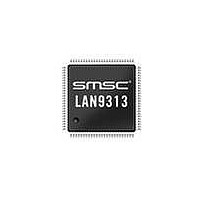LAN9313-NZW SMSC, LAN9313-NZW Datasheet - Page 22

LAN9313-NZW
Manufacturer Part Number
LAN9313-NZW
Description
Ethernet ICs Three Port 10/100 Ethernet Switch
Manufacturer
SMSC
Type
Three Port Managed Ethernet Switchr
Datasheet
1.LAN9313-NZW.pdf
(399 pages)
Specifications of LAN9313-NZW
Ethernet Connection Type
10 Base-T, 100 Base-TX
Minimum Operating Temperature
0 C
Mounting Style
SMD/SMT
Product
Ethernet Switches
Number Of Transceivers
1
Standard Supported
802.3, 802.3u
Data Rate
10 Mbps, 100 Mbps
Supply Voltage (max)
3.6 V
Supply Voltage (min)
0 V
Supply Current (max)
155 mA, 270 mA
Maximum Operating Temperature
+ 70 C
Package / Case
TQFP-100
Lead Free Status / RoHS Status
Lead free / RoHS Compliant
Available stocks
Company
Part Number
Manufacturer
Quantity
Price
Company:
Part Number:
LAN9313-NZW
Manufacturer:
Microchip Technology
Quantity:
10 000
Part Number:
LAN9313-NZW
Manufacturer:
SMSC
Quantity:
20 000
- Current page: 22 of 399
- Download datasheet (5Mb)
Revision 1.7 (06-29-10)
2.2.7
2.2.8
2.2.9
2.2.10
The I
detection, data bit transmission/reception, and acknowledge generation/reception), handles the slave
command protocol, and performs system register reads and writes. The I
to the Philips I
A list of management modes and configurations settings for these modes is discussed in
"Modes of Operation"
SMI Slave Controller
This module provides a SMI slave interface which can be used for CPU management of the
LAN9313/LAN9313i via the MII pins, and allows CPU access to all system CSRs. SMI uses the same
pins and protocol of the IEEE MII management function, and differs only in that SMI provides access
to all internal registers by using a non-standard extended addressing map. The SMI protocol co-exists
with the MII management protocol by using the upper half of the PHY address space (16 through 31).
A list of management modes and configurations settings for these modes is discussed in
"Modes of Operation"
EEPROM Controller/Loader
The EEPROM Controller is an I
EEPROM with the system register bus and the EEPROM Loader. Multiple types (I
sizes of external EEPROMs are supported. Configuration of the EEPROM type and size are
accomplished via the eeprom_type_strap and eeprom_size_strap[1:0] configuration straps respectively.
Various commands are supported for each EEPROM type, allowing for the storage and retrieval of
static data. The I
The EEPROM Loader module interfaces to the EEPROM Controller, Ethernet PHYs, and the system
CSRs. The EEPROM Loader provides the automatic loading of configuration settings from the
EEPROM into the LAN9313/LAN9313i at reset, allowing the LAN9313/LAN9313i to operate
unmanaged. The EEPROM Loader runs upon a pin reset (nRST), power-on reset (POR), digital reset
(DIGITAL_RST bit in the
command via the
1588 Time Stamp
The IEEE 1588 Time Stamp modules provide hardware support for the IEEE 1588 Precision Time
Protocol (PTP), allowing clock synchronization with remote Ethernet devices, packet time stamping,
and time driven event generation. Time stamping is supported on all ports, with an individual IEEE
1588 Time Stamp module connected to each port via the MII bus. Any port may function as a master
or a slave clock per the IEEE 1588 specification, and the LAN9313/LAN9313i as a whole may function
as a boundary clock.
A 64-bit tunable clock is provided that is used as the time source for all IEEE 1588 time stamp related
functions. The IEEE 1588 Clock/Events block provides IEEE 1588 clock comparison based interrupt
generation and time stamp related GPIO event generation. Two LAN9313/LAN9313i GPIO pins
(GPIO[8:9]) can be used to trigger a time stamp capture when configured as an input, or output a
signal from the GPIO based on an IEEE 1588 clock target compare event when configured as an
output. All features of the IEEE 1588 hardware time stamp unit can be monitored and configured via
their respective IEEE 1588 configuration and status registers (CSRs).
GPIO/LED Controller
The LAN9313/LAN9313i provides 12 configurable general-purpose input/output pins which are
controlled via this module. These pins can be individually configured via the GPIO/LED CSRs to
function as inputs, push-pull outputs, or open drain outputs and each is capable of interrupt generation
with configurable polarity. Two of the GPIO pins (GPIO[9:8]) can be used for IEEE 1588 timestamp
functions, allowing GPIO driven 1588 time clock capture when configured as an input, or GPIO output
generation based on an IEEE 1588 clock target compare event.
2
C slave controller implements the low level I
2
C-Bus Specification.
2
C interface conforms to the Philips I
EEPROM Command Register
Reset Control Register
2
C/Microwire master module which interfaces an optional external
DATASHEET
22
(E2P_CMD).
(RESET_CTL)), or upon the issuance of a RELOAD
2
C slave serial interface (start and stop condition
2
C-Bus Specification.
Three Port 10/100 Managed Ethernet Switch with MII
2
C slave controller conforms
SMSC LAN9313/LAN9313i
2
C/Microwire) and
Section 2.3,
Section 2.3,
Datasheet
Related parts for LAN9313-NZW
Image
Part Number
Description
Manufacturer
Datasheet
Request
R

Part Number:
Description:
Ethernet ICs Three Port 10/100 Ethernet Switch
Manufacturer:
SMSC
Datasheet:

Part Number:
Description:
FAST ETHERNET PHYSICAL LAYER DEVICE
Manufacturer:
SMSC Corporation
Datasheet:

Part Number:
Description:
357-036-542-201 CARDEDGE 36POS DL .156 BLK LOPRO
Manufacturer:
SMSC Corporation
Datasheet:

Part Number:
Description:
357-036-542-201 CARDEDGE 36POS DL .156 BLK LOPRO
Manufacturer:
SMSC Corporation
Datasheet:

Part Number:
Description:
357-036-542-201 CARDEDGE 36POS DL .156 BLK LOPRO
Manufacturer:
SMSC Corporation
Datasheet:

Part Number:
Description:
4-PORT USB2.0 HUB CONTROLLER
Manufacturer:
SMSC Corporation
Datasheet:

Part Number:
Description:
Manufacturer:
SMSC Corporation
Datasheet:

Part Number:
Description:
Manufacturer:
SMSC Corporation
Datasheet:

Part Number:
Description:
FDC37C672ENHANCED SUPER I/O CONTROLLER WITH FAST IR
Manufacturer:
SMSC Corporation
Datasheet:

Part Number:
Description:
COM90C66LJPARCNET Controller/Transceiver with AT Interface and On-Chip RAM
Manufacturer:
SMSC Corporation
Datasheet:

Part Number:
Description:
Manufacturer:
SMSC Corporation
Datasheet:

Part Number:
Description:
Manufacturer:
SMSC Corporation
Datasheet:

Part Number:
Description:
Manufacturer:
SMSC Corporation
Datasheet:

Part Number:
Description:
Manufacturer:
SMSC Corporation
Datasheet:











